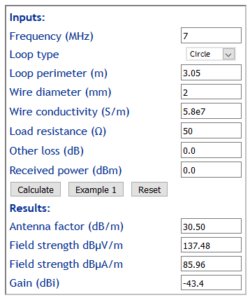A correspondent reading recent articles on active loops for receiving asks:
I have a 30″ square loop of #12 wire that I use for receiving, and when I attach it to the receiver on 40m, the audio output voltage goes up three times or more. Do I need an amplifiers, or will it worsen things?
It is possible to determine the ambient noise temperature from the true noise power change over that of a matched termination.
The equivalent noise temperature of the receiver is implied by its Noise Figure when it is terminated with a matched termination. Noise due to an open circuit or short circuit input is not defined.
The correspondent re-measured with a termination, and as it turned out, the results were much the same, so lets work the case of voltage increasing by a factor of three.
Without going any further, we can calculate the degradation in External S/N by the receiver, total noise power is proportional to (3^2) times internal noise, so S/N degradation is 10*log(9/(9-1))=0.51dB… very little.
It is true that an amplifier is unlikely to improve things and will be likely to degrade things because of intermodulation distortion that is inherent in them, more so if it overloads on broadband signal input.
But let’s go on to estimate the ambient noise figure Fa.
It is really important for this process that the AGC does not change the receiver gain, and there is no overload or clipping. The latter means DO NOT SWITCH THE AGC OFF, the S meter deflects, you need extra input attenuation to keep things linear.
Now lets assume the receiver has a Noise Figure of 6dB (most modern HF transceivers are in that ball park).
We need to estimate the gain of the antenna, we will use Calculate small loop Antenna Factor.
Ok, terminated in 50Ω, the untuned small loop has a gain of -43.4dBi. So, it captures only a very small portion of the external noise, but even so it delivers sufficient to the receiver to increase the output voltage by a factor of 3. Continue reading Small untuned loop for receiving – is an amplifier necessary?










